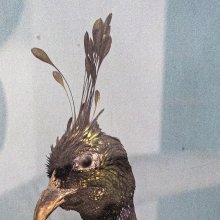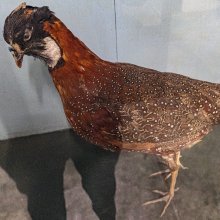Pheasant: 1 definition
Introduction:
Pheasant means something in Buddhism, Pali. If you want to know the exact meaning, history, etymology or English translation of this term then check out the descriptions on this page. Add your comment or reference to a book if you want to contribute to this summary article.
Images (photo gallery)
In Buddhism
Tibetan Buddhism (Vajrayana or tantric Buddhism)
Source: academia.edu: The Structure and Meanings of the Heruka MaṇḍalaThe Pheasant (animal) is associated with the Yoginī (female deity) named Kapiñjalī, being situated in the Vāyucakra, according to the 10th century Ḍākārṇava-tantra: one of the last Tibetan Tantric scriptures belonging to the Buddhist Saṃvara tradition consisting of 51 chapters.—Accordingly, the vāyucakra refers to one of the three divisions of the dharma-puṭa (‘dharma layer’), situated in the Herukamaṇḍala. The 36 pairs of Ḍākinīs [viz., Kapiñjalī—“Pheasant”] and Vīras are dark blue in color; they each have one face and four arms; they hold a skull bowl, a skull staff, a small drum, and a knife.

Tibetan Buddhism includes schools such as Nyingma, Kadampa, Kagyu and Gelug. Their primary canon of literature is divided in two broad categories: The Kangyur, which consists of Buddha’s words, and the Tengyur, which includes commentaries from various sources. Esotericism and tantra techniques (vajrayāna) are collected indepently.
See also (Relevant definitions)
Starts with: Pheasant pepper tree.
Full-text (+29): Jivajiva, Vijana, Vishadarshanamrityuka, Karkkana, Vishamrityu, Cambota, Cembuta, Sambarakage, Summer pheasant's-eye, Pheasant pepper tree, Pheasant's-eye, Kukkubha, Pheasant's-wings, Common pheasant-berry, Jibajiva, Kembuta, Kukkuli, Kukkali, Daphe, Damphe.
Relevant text
Search found 18 books and stories containing Pheasant; (plurals include: Pheasants). You can also click to the full overview containing English textual excerpts. Below are direct links for the most relevant articles:
The Markandeya Purana (by Frederick Eden Pargiter)
Maha Prajnaparamita Sastra (by Gelongma Karma Migme Chödrön)
Story of the pheasant extinguishing a jungle fire < [Chapter XXVII - The Virtue of Exertion]
Part 10 - Tittiriyaṃ brahmacariyaṃ (the religious life of the pheasant) < [Chapter XX - The Virtue of Generosity and Generosity of the Dharma]
Part 4 - Bodily and mental exertion < [Chapter XXVII - The Virtue of Exertion]
Tibetan tales (derived from Indian sources) (by W. R. S. Ralston)
Chapter 49 - The united Pheasants
Chapter 12 - The story of Suśroṇī
The Great Chronicle of Buddhas (by Ven. Mingun Sayadaw)
Part 5 - Discourses delivered by the Buddha with Reference to Venerable Rāhula < [Chapter 31 - The Monk Sudinna, the Son of the Kalanda Merchant]
Discourse on Kuṇāla Jātaka < [Chapter 22 - Founding of Vesali]
The Treatise on the Marks of a Great Man < [Chapter 1 - The Jewel of the Buddha]
Apadana commentary (Atthakatha) (by U Lu Pe Win)
Commentary on Biography of the thera Tiṇasantharadāyaka < [Chapter 8 - Nagasamālavagga (section on Nagasamāla)]
Commentary on the biography of the the thera Sāriputta < [Chapter 1 - Buddhavagga (Buddha section)]
Kautilya Arthashastra (by R. Shamasastry)
Chapter 26 - The Superintendent of Slaughter-house < [Book 2 - The duties of Government Superintendents]
Chapter 20 - Duty towards the Harem < [Book 1 - Concerning Discipline]


